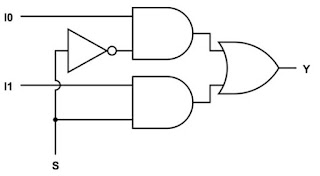HALF ADDER UDP Style Verilog
HALF ADDER (User Defined Primitive (UDP) Style)
_______________________________________________________________________________
primitive HA_sum(Sum, a, b); // Similar to module, output 1st, then inputs
input a, b;
output Sum; // for combinational ckt, output must be of output type
table
// a b : sum // input's order must be same
0 0 : 0;
0 1 : 1;
1 0 : 1;
1 1 : 0;
endtable
endprimitive
primitive HA_Cout(Cout, a, b); // For each output, separate UDP is defined
input a, b;
output Cout;
table
// a b : Cout
0 0 : 0;
0 1 : 0;
1 0 : 0;
1 1 : 1;
endtable
endprimitive
_______________________________________________________________________________
Test Bench
_______________________________________________________________________________
module HA_test;
reg a,b;
wire Sum, Cout;
HA_sum HA1 (Sum, a, b); // Instantiation
HA_Cout (Cout, a, b); // Instantiation, name is optional
initial
begin
$display("a b \t Sum Carry");
$monitor("%b %b \t %b %b", a,b,Sum,Cout);
a=1'b0; b=1'b0;
#5 a=1'b0; b=1'b1;
#5 a=1'b1; b=1'b0;
#5 a=1'b1; b=1'b1;
#5 $finish;
end
endmodule
_________________________________________________________________________________
Output
________________________
a b Sum Carry
0 0 0 0
0 1 1 0
1 0 1 0
1 1 0 1
_________________________
User Defined Primitive (UDP)
- Behavioral/Functional Codes can be expressed in a form of Boolean expression (Data flow type (assign)) and in form of truth tables (Using UDP).
- So UDP tables also defines the behavior/functionality of a system.
- In both cases, only behavior of circuit is expressed.
- It doesn't tell about the internal circuit design i.e. which gates are used normal logical gates or universal gates, how they are interconnected or at transistor level how transistors are interconnected.
_______________________________________________________________________________
primitive HA_sum(Sum, a, b); // Similar to module, output 1st, then inputs
input a, b;
output Sum; // for combinational ckt, output must be of output type
table
// a b : sum // input's order must be same
0 0 : 0;
0 1 : 1;
1 0 : 1;
1 1 : 0;
endtable
endprimitive
primitive HA_Cout(Cout, a, b); // For each output, separate UDP is defined
input a, b;
output Cout;
table
// a b : Cout
0 0 : 0;
0 1 : 0;
1 0 : 0;
1 1 : 1;
endtable
endprimitive
_______________________________________________________________________________
Test Bench
_______________________________________________________________________________
module HA_test;
reg a,b;
wire Sum, Cout;
HA_sum HA1 (Sum, a, b); // Instantiation
HA_Cout (Cout, a, b); // Instantiation, name is optional
initial
begin
$display("a b \t Sum Carry");
$monitor("%b %b \t %b %b", a,b,Sum,Cout);
a=1'b0; b=1'b0;
#5 a=1'b0; b=1'b1;
#5 a=1'b1; b=1'b0;
#5 a=1'b1; b=1'b1;
#5 $finish;
end
endmodule
_________________________________________________________________________________
Output
________________________
a b Sum Carry
0 0 0 0
0 1 1 0
1 0 1 0
1 1 0 1
_________________________
User Defined Primitive (UDP)
- It is used to define truth table and state table.
- Each UDP can be used to implement single function (or single output).
- No vector declaration.
- In port list, a single output variable is written first, then input variables are mentioned.
- Syntax for truth table: <inputs> : <output>
- Inputs must be mentioned in same order as in port list.
- For combinational circuit, output is declared as output.
- For sequential circuit, output is declared as reg.
- Default output is x (don't care)
- At max 10 input variables can be defined for combinational ckt and 9 input variables can be defined for sequential ckt.



Comments
Post a Comment